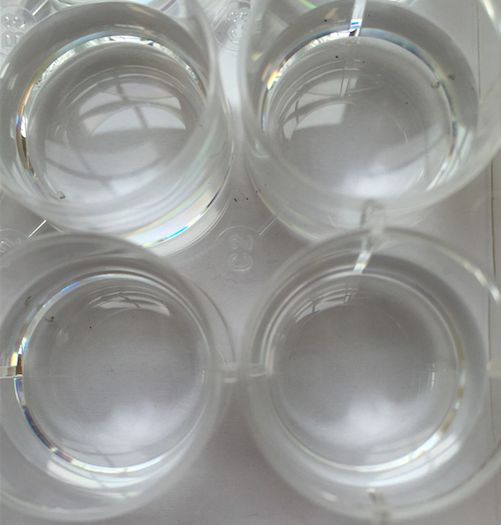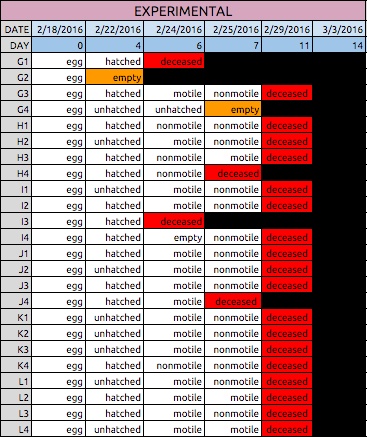User:Student 57/Notebook/Biology 210 at AU: Difference between revisions
Lauren Wason (talk | contribs) No edit summary |
Lauren Wason (talk | contribs) No edit summary |
||
| (18 intermediate revisions by 2 users not shown) | |||
| Line 1: | Line 1: | ||
''' | '''Zebrafish''' | ||
March 10, 2016 | |||
''Purpose'' <br> | ''Purpose''<br> | ||
The purpose of this experiment was to observe the impact of movement disruption on the embryological development of zebrafish. It was hypothesized that the constant motion that the experimental group was exposed to would stunt their growth in comparison to the control group. | |||
''Materials and Methods'' <br> | ''Materials and Methods''<br> | ||
The experiment began with 48 total zebrafish, 24 in a control group and 24 in an experimental group. The experimental group was exposed to 200 RPM on a Hybrid Capture System machine 24 hours a day for the 14 day duration of the experiment. The zebrafish were kept in individual petri dishes with deerpark water with anti-fungal methylene blue treatment. The zebrafish were observed every few days to determine the impact of motion on development. | |||
''Data and Observations''<br> | |||
[[Image:WasonZebraEmbry.png]] | |||
Figure 1. Stages of embryonic development of zebrafish. | |||
[[Image: | [[Image:WasonWells1.png]]<br> | ||
Figure 2. Embryonic growth of the control group. | |||
[[Image:WasonWells2.png]] <br> | |||
Figure 3. Embryonic growth of experimental group. | |||
[[Image: | [[Image:Embryo2.png]]<br> | ||
Figure 4. Control group embryo. | |||
[[Image: | [[Image:Embryo1.png]]<br> | ||
Figure 5. Experimental group embryo. | |||
[[Image: | [[Image:Wason_Control.png]]<br> | ||
Table 1. Zebrafish control results. | |||
[[Image: | [[Image:Wason_Experimental.png]] <br> | ||
Table 2. Zebrafish experimental results. | |||
''Conclusions and Future Directions''<br> | |||
By the end of the experiment, all of the zebrafish had died. The group that was exposed to consistent motion died earlier than the control group. As seen in figures 2-5, the embryonic growth of the experimental group was visibly quicker than that of the control group. The differences in movement in the experimental and control groups were not very different throughout the duration of the experiment. Continued study of disrupted motion would help to discover more about its impact on vertebrates. | |||
LW | |||
'''Vertebrates''' | |||
March 3, 2016 | |||
''Purpose''<br>The purpose of this experiment was to consider the vertebrates that inhabit Transect Four and create a food web depicting the tropic levels of the overall ecosystem. | |||
'' | ''Materials and Methods''<br> | ||
Using data from previous experiments, the vertebrate populations of Transect Four were extrapolated. Using the textbook, the vertebrates were classified into species and abiotic and biotic factors that benefitted each were identified. | |||
''Observations and Data''<br> | |||
[[Image:Wason31.png]]<br> | |||
Table 1. Identified vertebrates. | |||
[[Image:WasonFoodWeb.png]] | |||
Figure 1. Food Web from Transect Four. | |||
[[Image: | |||
The food web depicts a ''community'', where each of these species interacts with one another in a particular area, which would be Transect Four. The species that were found in Transect Four demonstrate the ''carrying capacity'' of the environment, in that only a certain number of a certain species can inhabit this area. The different ''trophic levels'' of each of the species show where they would be on the food chain in this ecosystem. | |||
'''Transect Four | ''Conclusions and Future Directions''<br> | ||
The vertebrates in range four are assumed to have a number of different species. Due to the unique pond ecosystem, it was expected that all of the organisms present would interact with the water and benefit from this in the environment. The relationships among the organisms present in Transect Four, depicted in Figure 1, show how they organisms interact in varying trophic levels. The energy that passes through the ecosystem relies on every organism, from the eukaryotic bacteria to the vertebrate mammalia. The continued study of transects on the American University campus will continue to build the knowledge of the ecosystem as a whole. | |||
LW | |||
'''16S Sequence Analysis''' | |||
February 24, 2016 | |||
''Purpose:'' <br> | |||
The purpose of this experiment was to determine the species of soil bacteria collected from Transect Four using a nucleotide sequence for the 16S rRNA gene through the polymerase chain reaction technique (PCR). | |||
''Materials and Methods:'' <br> | |||
A sample of bacteria collected from Transect 4 was amplified using PCR and sent to a lab for sequencing. The sequence of nucleotides was entered into BLAST to determine the species of bacteria. | |||
''Observations and Data:'' <br> | |||
A Blast was done using the following nucleotide sequence for Transect Four borrowed from Ricardo Rodriguez: | |||
CTCCTNNNACGNGTCACCGNCTTCAGGTACCCCATNNNNNCCATGGCTTGACGGGC GGTGTGTACAAGGCCCGGGAACGTATTCACCGCGCCATGGCTGATGCGCGATTACTAGCGATTCCAGCTTCATAGAGTCG AGTTGCAGACTCCAATCCGAACTGAGACCAGCTTTCGAGATTCGCATCCAGTCACCTGGTAGCTGCCCTCTGTACTGGCC ATTGTATTACGTGTGTGGCCCAAGGCGTAAGGGCCGTGATGATTTGACGTCATCCCCACCTTCCTCTCTACTTGCGTAGG CAGTCTCACTAGAGTCCCCAACTGAATGATGGCAACTAGTGACAGGGGTTGCGCTCGTTGCAGGACTTAACCTAACACCT CACGGCACGAGCTGACGACAACCATGCAGCACCTTGAAAAATGTCCGAAGAAAAGTCTATTTCTAA | |||
Latest revision as of 10:01, 8 March 2016
Zebrafish
March 10, 2016
Purpose
The purpose of this experiment was to observe the impact of movement disruption on the embryological development of zebrafish. It was hypothesized that the constant motion that the experimental group was exposed to would stunt their growth in comparison to the control group.
Materials and Methods
The experiment began with 48 total zebrafish, 24 in a control group and 24 in an experimental group. The experimental group was exposed to 200 RPM on a Hybrid Capture System machine 24 hours a day for the 14 day duration of the experiment. The zebrafish were kept in individual petri dishes with deerpark water with anti-fungal methylene blue treatment. The zebrafish were observed every few days to determine the impact of motion on development.
Data and Observations
Figure 1. Stages of embryonic development of zebrafish.

Figure 2. Embryonic growth of the control group.

Figure 3. Embryonic growth of experimental group.

Figure 4. Control group embryo.

Figure 5. Experimental group embryo.

Table 1. Zebrafish control results.

Table 2. Zebrafish experimental results.
Conclusions and Future Directions
By the end of the experiment, all of the zebrafish had died. The group that was exposed to consistent motion died earlier than the control group. As seen in figures 2-5, the embryonic growth of the experimental group was visibly quicker than that of the control group. The differences in movement in the experimental and control groups were not very different throughout the duration of the experiment. Continued study of disrupted motion would help to discover more about its impact on vertebrates.
LW
Vertebrates
March 3, 2016
Purpose
The purpose of this experiment was to consider the vertebrates that inhabit Transect Four and create a food web depicting the tropic levels of the overall ecosystem.
Materials and Methods
Using data from previous experiments, the vertebrate populations of Transect Four were extrapolated. Using the textbook, the vertebrates were classified into species and abiotic and biotic factors that benefitted each were identified.
Observations and Data

Table 1. Identified vertebrates.
 Figure 1. Food Web from Transect Four.
Figure 1. Food Web from Transect Four.
The food web depicts a community, where each of these species interacts with one another in a particular area, which would be Transect Four. The species that were found in Transect Four demonstrate the carrying capacity of the environment, in that only a certain number of a certain species can inhabit this area. The different trophic levels of each of the species show where they would be on the food chain in this ecosystem.
Conclusions and Future Directions
The vertebrates in range four are assumed to have a number of different species. Due to the unique pond ecosystem, it was expected that all of the organisms present would interact with the water and benefit from this in the environment. The relationships among the organisms present in Transect Four, depicted in Figure 1, show how they organisms interact in varying trophic levels. The energy that passes through the ecosystem relies on every organism, from the eukaryotic bacteria to the vertebrate mammalia. The continued study of transects on the American University campus will continue to build the knowledge of the ecosystem as a whole.
LW
16S Sequence Analysis
February 24, 2016
Purpose:
The purpose of this experiment was to determine the species of soil bacteria collected from Transect Four using a nucleotide sequence for the 16S rRNA gene through the polymerase chain reaction technique (PCR).
Materials and Methods:
A sample of bacteria collected from Transect 4 was amplified using PCR and sent to a lab for sequencing. The sequence of nucleotides was entered into BLAST to determine the species of bacteria.
Observations and Data:
A Blast was done using the following nucleotide sequence for Transect Four borrowed from Ricardo Rodriguez:
CTCCTNNNACGNGTCACCGNCTTCAGGTACCCCATNNNNNCCATGGCTTGACGGGC GGTGTGTACAAGGCCCGGGAACGTATTCACCGCGCCATGGCTGATGCGCGATTACTAGCGATTCCAGCTTCATAGAGTCG AGTTGCAGACTCCAATCCGAACTGAGACCAGCTTTCGAGATTCGCATCCAGTCACCTGGTAGCTGCCCTCTGTACTGGCC ATTGTATTACGTGTGTGGCCCAAGGCGTAAGGGCCGTGATGATTTGACGTCATCCCCACCTTCCTCTCTACTTGCGTAGG CAGTCTCACTAGAGTCCCCAACTGAATGATGGCAACTAGTGACAGGGGTTGCGCTCGTTGCAGGACTTAACCTAACACCT CACGGCACGAGCTGACGACAACCATGCAGCACCTTGAAAAATGTCCGAAGAAAAGTCTATTTCTAA
